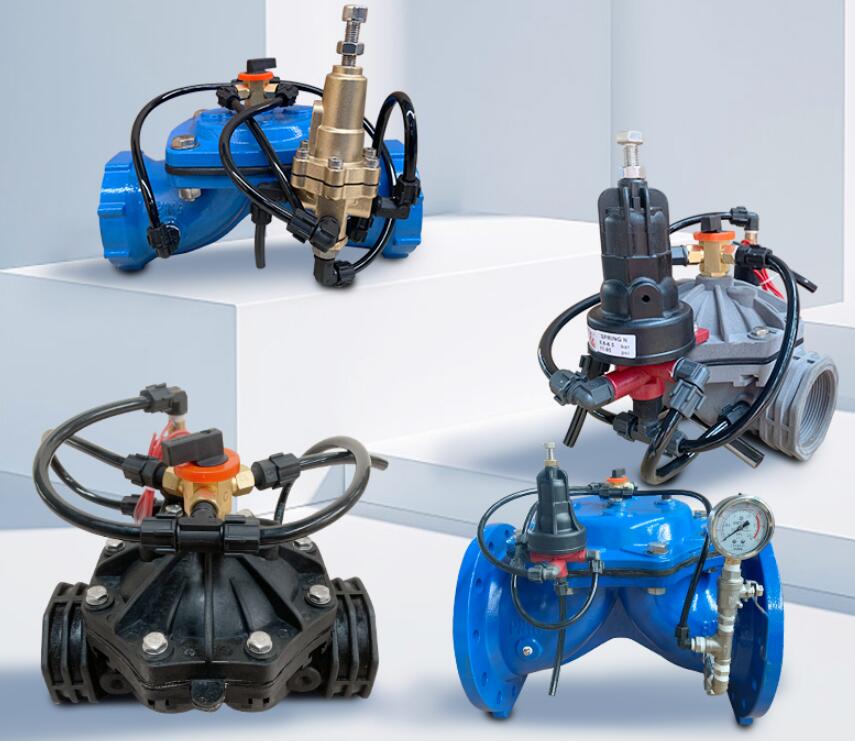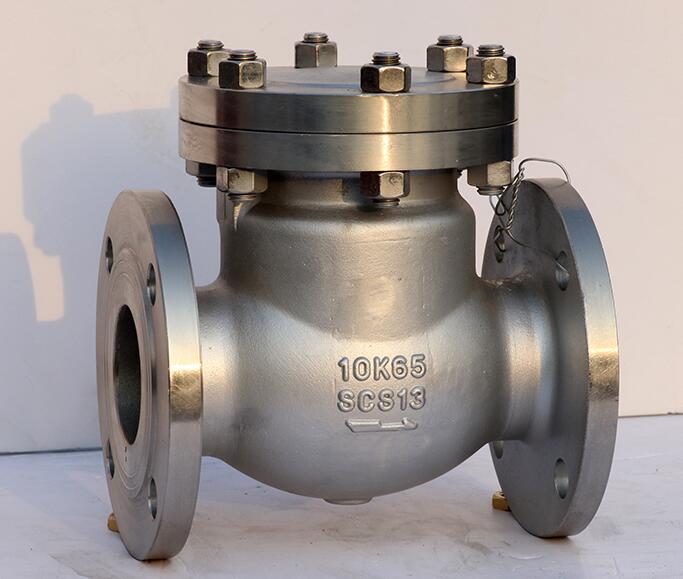válvulas unidireccionales también llamado revisar válvulas o válvulas antirretorno. Es una válvula donde el fluido solo puede fluir a lo largo de la entrada y el medio en la salida no puede regresar..
Se utiliza en sistemas hidráulicos para evitar el flujo inverso de aceite., o en sistemas neumáticos para evitar el flujo inverso del aire comprimido. Desempeñan un papel crucial en diversas industrias al garantizar el flujo unidireccional de sustancias en las tuberías., sistemas, Y equipamiento, mejorando así la seguridad, eficiencia, y rendimiento.

Las válvulas unidireccionales tienen tipo dos rectas y de ángulo recto.
Tipo unidireccional directo
con una conexión roscada instalada en la tubería.
Una válvula unidireccional de paso directo es un tipo de válvula que permite que el fluido o el gas fluya en una sola dirección y evita el flujo inverso.. Presenta un diseño directo., facilitando el paso de flujo sin obstrucciones para una mayor eficiencia y una caída de presión mínima. Esta válvula se usa comúnmente en aplicaciones donde mantener el flujo direccional es fundamental., como en sistemas de plomería, irrigación, y procesos industriales.
El tipo unidireccional en ángulo recto tiene tres formas
Conexión roscada, conexión soldada y conexión de brida.
Una válvula unidireccional de ángulo recto es un tipo de válvula diseñada para regular el flujo de fluido o gas en una sola dirección evitando al mismo tiempo el reflujo.. Presenta una configuración en forma de L o en ángulo recto., permitiendo la instalación en espacios reducidos o donde se requiere una conexión perpendicular. Esta válvula se usa comúnmente en diversas industrias., incluyendo automoción, dispositivos médicos, y sistemas HVAC, donde existen limitaciones de espacio o requisitos de instalación específicos.
Tipos de válvulas unidireccionales

Clasificación basada en diseño y mecanismo.
Los tipos de válvulas de retención son: tipo de resorte, tipo de gravedad, tipo columpio, tipo de diafragma de plástico. Según la estructura: válvulas de retención de elevación, válvulas de retención de mariposa, válvulas de retención oscilantes, válvula de retención de bola y válvula de retención de trampilla.
- Válvula de retención de elevación: Dividido en control vertical., control horizontal.
- Válvula de retención oscilante: Dividido en control de válvula única., válvulas de doble retención, control de solapas múltiples.
- Válvulas de retención de bola: Las válvulas de retención de bola son dispositivos mecánicos que se utilizan para controlar el flujo de fluidos o gases en tuberías permitiendo el flujo en una dirección y evitando el reflujo en la dirección opuesta.. Consisten en una bola esférica dentro de un cuerpo de válvula., que se mueve libremente para permitir el flujo cuando la presión en el lado de entrada es mayor que en el lado de salida. Cuando el flujo se invierte, la pelota se mueve para bloquear el paso, evitando el reflujo.
- Válvulas de retención de aleta: Las válvulas de retención de aleta son dispositivos mecánicos diseñados para regular el flujo de fluido o gas en tuberías permitiendo el flujo en una dirección y evitando el reflujo en la dirección opuesta.. Cuentan con una aleta o disco con bisagras que se abre en la dirección del flujo y se cierra para bloquear el flujo inverso.. Este diseño permite un control de flujo eficiente., Prevenir la inversión de fluido o gas y garantizar la integridad del sistema de tuberías.. Las válvulas de retención de mariposa se utilizan ampliamente en diversas industrias debido a su confiabilidad., bajos requisitos de mantenimiento, y eficacia en la prevención del reflujo.
Válvulas antirretorno según el formulario de conexión.: tipo de cheque roscado, tipo de control soldado, tipo de control de brida.
Clasificación basada en la aplicación
| tipo medio | Materiales recomendados |
| Líquidos corrosivos | Acero inoxidable, aleación de acero |
| Ácidos y álcalis fuertes | PTFE (politetrafluoroetileno) |
| Vapor de alta temperatura | Aleaciones especiales resistentes al calor. |
- válvulas de retención hidráulicas Son componentes esenciales en los sistemas hidráulicos., Diseñado para controlar el flujo de fluido en una dirección y al mismo tiempo evitar el flujo inverso.. Utilizan mecanismos internos, como discos con resorte o válvulas de retención para permitir que el fluido fluya en una dirección., mientras se cierra automáticamente para bloquear el flujo en la dirección opuesta. Estas válvulas garantizan la integridad y eficiencia de los sistemas hidráulicos al evitar el reflujo de fluido., que podría causar daños o mal funcionamiento.
- Válvulas de retención neumáticas Son dispositivos utilizados en sistemas neumáticos para regular el flujo de aire comprimido o gases en una dirección evitando el flujo inverso.. Operan mediante mecanismos internos como discos con resorte o válvulas de retención., que se abren para permitir el flujo de aire en una dirección y se cierran para bloquear el flujo de aire en la dirección opuesta. Estas válvulas aseguran el correcto funcionamiento de los sistemas neumáticos evitando el reflujo., que podría interrumpir las operaciones o dañar el equipo.
- válvulas de retención médicas son componentes especializados que se utilizan en dispositivos y equipos médicos para controlar el flujo de fluidos o gases en una dirección y al mismo tiempo evitar el reflujo.. Estas válvulas son cruciales para mantener la integridad de los sistemas médicos., garantizar la entrega adecuada de medicamentos, gases, o líquidos a los pacientes durante procedimientos o tratamientos. Operan mediante mecanismos como bola., diafragma, o diseños con resorte para permitir el flujo en una dirección mientras bloquea el flujo en la dirección opuesta.
- válvulas de pico de pato Son válvulas de retención pasivas unidireccionales diseñadas para permitir el flujo de fluido o gas en una dirección y al mismo tiempo evitar el reflujo.. Su forma única se asemeja al pico de un pato., de ahí el nombre. Estas válvulas constan de un material elastomérico flexible., como silicona o caucho, formado en una forma cónica que naturalmente permanece cerrada cuando no se aplica presión. Cuando un fluido o gas fluye en la dirección deseada, la presión abre la válvula, permitiendo el paso. Sin embargo, cuando el flujo se detiene o se invierte, la elasticidad de la válvula hace que se cierre, evitando el reflujo. Las válvulas de pico de pato encuentran aplicaciones en diversas industrias, incluyendo dispositivos médicos, tratamiento de aguas residuales, automotor, y aeroespacial, donde es esencial un control de flujo unidireccional confiable.
- Válvulas de alivio de presión Son dispositivos de seguridad que se utilizan para proteger equipos o sistemas contra la acumulación excesiva de presión al abrirse automáticamente para liberar el exceso de presión.. Operan detectando la presión en un sistema y, cuando excede un umbral predeterminado, Se abren para permitir la liberación de fluido o gas., evitando así daños o fallas catastróficas. Las válvulas de alivio de presión son componentes cruciales en diversas industrias., incluyendo petróleo y gas, procesamiento químico, generación de energía, y tratamiento de agua, donde mantener presiones operativas seguras es esencial. Vienen en diferentes diseños., incluyendo con resorte, operado por piloto, y fuelle equilibrado, cada uno adecuado para aplicaciones y rangos de presión específicos.
Tipo de cheque ordinario
Las estructuras de control ordinarias permiten el flujo de fluido en una sola dirección.. La presión de apertura hacia adelante es generalmente de 0,03 a 0,05 Mpa..
Las principales aplicaciones de las válvulas unidireccionales ordinarias.:
- La válvula generalmente instalada en la salida de la bomba.. Porque el choque de presión afectará el funcionamiento normal de la bomba.. Y evita que la bomba no funcione cuando el sistema tiene reflujo de aceite..
- Las válvulas unidireccionales también son capaces de funcionar en cámaras separadas de alta y baja presión..
- Los tipos de válvulas unidireccionales son: válvulas de mariposa unidireccionales, válvulas reductoras de presión unidireccionales, válvulas de secuencia unidireccional.
- En las válvulas de contrapresión., Las válvulas de retención instalan la ruta de retorno..
Tipo directo
Válvulas de retención de paso directo en la dirección del flujo de aceite y la dirección del eje de la válvula es la misma.
Válvulas de conexión de tuberías, El puerto de aceite de dicha válvula se puede conectar a la tubería de aceite a través del conector de tubería.. El peso de su cuerpo de válvula depende del soporte de la tubería., por lo que el volumen de la válvula no puede ser demasiado grande ni demasiado pesado.
Válvulas unidireccionales en ángulo recto
El eje de la entrada y salida de las válvulas de retención en ángulo recto es perpendicular al eje del cuerpo de la válvula..
Consideraciones de selección
Al seleccionar una válvula de retención, Se deben considerar varios factores clave para garantizar un rendimiento y confiabilidad óptimos en una aplicación específica.. Estos factores incluyen la presión de funcionamiento., requisitos de flujo, características de los medios, rango de temperatura, y selección de materiales. Los detalles son los siguientes.:
- Presión laboral es la base para la selección. La presión de trabajo de la válvula de retención debe coincidir con la presión de trabajo máxima del sistema para garantizar que la válvula pueda mantener un sello estable bajo alta presión.. Por ejemplo, en equipos de corte por chorro de agua a alta presión, La presión de trabajo de la válvula de retención debe alcanzar cientos de MPa para evitar el flujo inverso de agua a alta presión..
- Requisitos de flujo Afecta directamente el tamaño y la velocidad de respuesta de la válvula.. Una selección inadecuada puede provocar una pérdida de presión o un retraso en la respuesta.. Para aplicaciones de gran flujo, como grandes sistemas hidráulicos, Puede ser necesario seleccionar una válvula de retención controlada hidráulicamente de gran flujo especialmente diseñada con un flujo nominal de más de 1000 l/min..
- Consideración de características de los medios es particularmente importante. Diferentes medios tienen diferentes requisitos para los materiales y sellos de las válvulas.: lista 1
- Rango de temperatura es otro parámetro clave. La elección de los materiales y sellos de las válvulas debe tener en cuenta la temperatura de funcionamiento para garantizar que puedan mantener un buen rendimiento en condiciones extremas.. Por ejemplo, Algunas válvulas de retención especiales pueden funcionar en un rango de temperatura extremadamente amplio de -196 °C a +850 °C[1].
- Además, método de montaje y conveniencia de mantenimiento necesita ser considerado. La elección de la conexión roscada., La conexión de brida o la soldadura deben coincidir con la interfaz del sistema.. La reemplazabilidad de las piezas de desgaste también afectará el coste operativo a largo plazo..
Consideraciones de instalación
Durante la instalación de la válvula de retención., además de la elección de dirección y posición, Hay algunas consideraciones clave que requieren atención especial para garantizar que la válvula pueda funcionar correctamente y maximizar su rendimiento.. Estas consideraciones son las siguientes:
1.control de sellado : Después de la instalación, Se debe realizar una verificación exhaustiva del sellado en la conexión entre la válvula de retención y la tubería.. Esto se puede hacer aplicando agua con jabón o un líquido especial para detectar fugas para observar si hay burbujas o fugas anormales.. Para sistemas de alta presión, Puede ser necesario utilizar un equipo de prueba de presión profesional para verificar el rendimiento del sellado..
2.control de vibraciones : En algunas aplicaciones, La válvula de retención puede producir vibraciones significativas.. Para reducir esta vibración, se pueden tomar las siguientes medidas:
- Utilice conectores flexibles o amortiguadores de vibraciones para conectar la válvula de retención y el sistema de tuberías.
- Instale un amortiguador o silenciador cerca de la válvula de retención.
- Ajuste la precarga del resorte de la válvula de retención según sea necesario.
3.Instalación de derivación : En algunos sistemas críticos, Se recomienda instalar una válvula de derivación manual junto a la válvula de retención.. Los beneficios de hacerlo incluyen:
- Operación de emergencia conveniente
- Cuándo es necesario reparar o reemplazar la válvula de retención, todo el sistema puede funcionar sin parar
- Mejorar la confiabilidad y seguridad general del sistema.
4.Soporte de canalización: Para válvulas de retención grandes o pesadas, Se debe proporcionar suficiente soporte para la tubería cerca del lugar de instalación.. Un soporte razonable no solo puede reducir la tensión sobre la válvula de retención, sino que también reduce la vibración del sistema de tuberías, mejorando así la estabilidad y vida útil de todo el sistema.
5.Conexión eléctrica: Para válvulas antirretorno con funciones de control eléctrico (como válvulas de retención eléctricas), se deben tener en cuenta los siguientes puntos:
- Instalar dispositivos de protección contra rayos y sobretensiones cuando sea necesario.
- Asegúrese de que la conexión eléctrica cumpla con las normas de seguridad pertinentes.
- Utilice cables y conectores de especificaciones adecuadas.
Descripción de tendencias e innovaciones emergentes de válvulas unidireccionales

Las tendencias e innovaciones emergentes en la tecnología de válvulas unidireccionales significan una fase transformadora en los mecanismos de control de fluidos.. Estos avances se caracterizan por un cambio hacia tecnologías más inteligentes., más eficiente, y soluciones ambientalmente sostenibles.
- Tecnologías de válvulas inteligentes:
- Integración de sensores y actuadores para monitoreo y control en tiempo real.
- Implementación de algoritmos de mantenimiento predictivo para un servicio proactivo.
- Materiales Sostenibles:
- Adopción de materiales ecológicos como polímeros de origen biológico y metales reciclables..
- Desarrollo de válvulas con huella ambiental reducida y ciclo de vida mejorado.
- Integración con IoT:
- Conectividad con Internet de las Cosas (IoT) plataformas para operación remota y análisis de datos.
- Utilización de soluciones basadas en la nube para gestión y optimización centralizadas..
- Mejoras de rendimiento:
- Capacidades de control de flujo mejoradas para una regulación precisa del flujo de fluido.
- Reducción de la caída de presión y del consumo de energía mediante diseños innovadores.
- Adaptación a las necesidades de la industria:
- Personalización de diseños de válvulas para cumplir con requisitos y aplicaciones industriales específicas..
- Soluciones personalizadas para entornos desafiantes, como condiciones corrosivas o de alta presión.
Estas tendencias e innovaciones emergentes reflejan el compromiso de la industria con la eficiencia., sostenibilidad, y avance tecnológico, allanando el camino para una nueva era de soluciones de control de fluidos.
